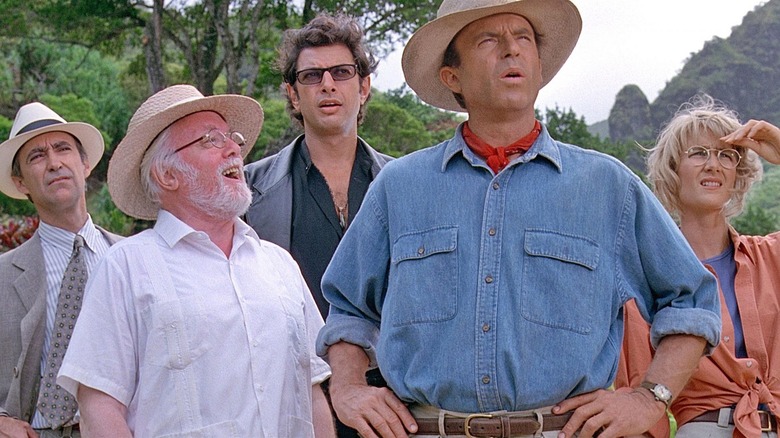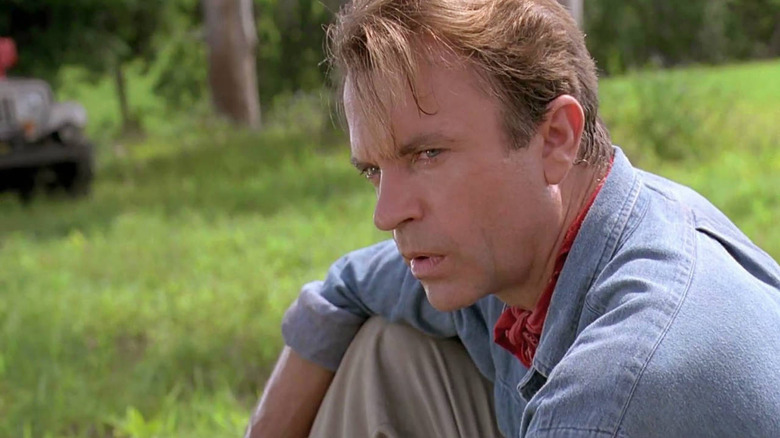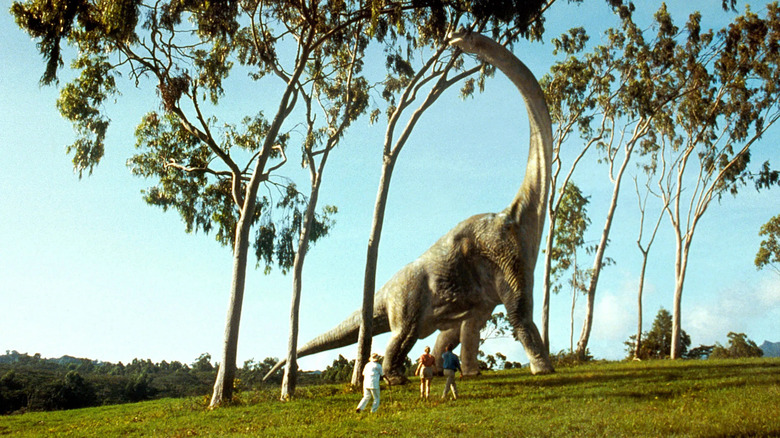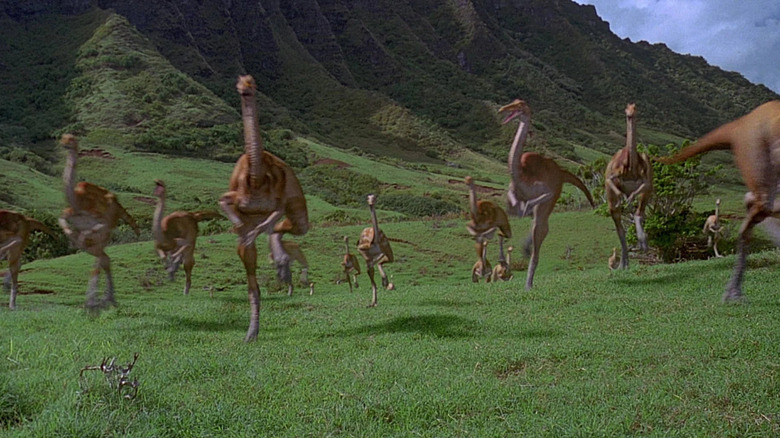Jurassic Park's CGI Tech Was A Test Of Patience For Its Stars
Few examples of early CGI in films hold up with each passing decade — fewer still can lay claim to actually looking better than modern renderings. Enter "Jurassic Park," a film that boasts such impressive digitally-enhanced dinosaurs that even modern attempts just don't cut it in comparison. But the extinct creatures in Steven Spielberg's film were brought to life using a mixture of both practical effects and CGI wizardry. Stan Winston ("Aliens") built the life-sized models and at one point the dinosaurs were going to be stop-motion animations of miniatures created by Phil Tippett. But that all changed when Tippett, Spielberg, and producer Kathleen Kennedy saw how mind-blowingly good initial CGI renderings looked. The smoking gun was an animation of a T-rex created by Steve "Spaz" Williams, which fundamentally changed not just how "Jurassic Park" would be made but every film thereafter. There have been plenty of critics of CGI since then – with the actors in "Jurassic Park" becoming some of the lighthearted first.
Spielberg told his actors to imagine the dinosaurs
Nothing really beats that first viewing you get as an audience of the dinosaurs. When John Hammond welcomes his guests to his nature-defying "Jurassic Park." A moment before the knees of Sam Neill's character — Alan Grant — buckle as he tries to process the sight of it all. But in an oral history compiled by EW, the actor's actual experience behind-the-scenes was drastically different.
"Steven said, 'Look over there and imagine there's a whole plain of grazing dinosaurs of all different stripes and persuasions. How would you feel about that?' And I said, 'Oh sh–. I don't know Steven, I think I'd faint!' That's why my knees go in the shot."
Obviously one of the drawbacks of relying on CGI for certain scenes meant the actors were often not joined by their dinosaur co-stars. Spielberg's solution? Make dinosaur noises to inspire his actors. "Steven was holding a bullhorn and roaring in a not very convincing way," Neill said. "It's difficult enough acting to a tennis ball, but it's even harder when you're trying not to laugh." It's a ridiculous image and Neill's right, it's a miracle everyone involved in the scene managed to give pretty convincing reactions to the imagined dinosaurs. Very quickly the cast of "Jurassic Park" learned that CGI didn't make everything easy. It also meant that unconvincing acting on their part could just as easily shatter the audience's experience as bad CGI.
Jurassic Park's actors had no idea how CGI worked
Thankfully the cast of "Jurassic Park" endured the oddities of early CGI with humor instead of frustration. A sign of the trust they placed in both Spielberg and the special effects team – even if they didn't exactly know what that team was even doing. Laura Dern, who plays Ellie Sattler, recalled being similarly oblivious via EW:
"I didn't even know what they were talking about. 'There's a piece of paper up there in the tree and it has an X on it. Just stare at that. That's a brachiosaurus.' And we were all like, 'Okay... is there still going to be an X when they see the movie, or are you going to put something else in?' 'No, no, Laura, we're going to put something else in.' [Laughs]"
Like Spielberg's roars or telling Neill to imagine herds of dinosaurs — Dern being told to pretend a piece of paper up in a tree is a brachiosaurus is pretty comical. But it's understandable the cast had missives here and there, CGI just wasn't the norm in 1993 and its methods were similarly unfamiliar to most actors.
Yet actors finding frustration with the technology is nothing new. CGI is regarded as a miracle worker to the audience but from the actor's point of view, it removes crucial objects, characters, and sometimes entire settings. Forcing them to act solely on imagination – which as the cast of "Jurassic Park" prove, is not a hurdle that can't be overcome by talented actors — feels counterintuitive. Especially when the CGI isn't that good or unnecessary. That obviously wasn't the case for "Jurassic Park" but that doesn't mean some of the younger cast took issue with not being able to shoot a scene with one of the film's animatronic dinos.
Even the kids suffered a deficiency of dinos
As a kid, I remember harboring no small jealousy towards Ariana Richards and Joseph Mazzello, the two actors who play Hammond's grandchildren Lex and Tim. In my mind, they'd spent countless time around these creatures – which I think I assumed to all be mechanical like the one's on the ride at Universal Studios theme park. But it turns out the kids had the same problem as the adults. In EW's oral history Mazzello revealed his ire: "For a long time, I was upset, because I didn't get to see any [dinosaurs]." He continued:
"We were running around in Hawaii with the gallimimus that were supposed to be running past us that were just computer-animated. And I remember one scene where the T. rex comes out of the woods, snatches one up, and eats it. What I got to look at was this wooden stick with a dinosaur head drawn at the top of it that I think I, as a 9-year-old, could have drawn and a couple of guys moving it around and Steven screaming into a megaphone, 'Okay, now he's eating him, Joe. He's eating him now. You're looking at him. He's eating him.' I was a little upset."
One imagines a childlike doodle of a dinosaur at the top of that wooden stick. Spielberg's "imagine it" trick might've barely worked with Neill and Dern – but clearly, Mazzello wasn't having it: "I was like 'Yo, when are we getting some dinosaurs. I keep hearing this movie's about dinosaurs.'" It's doubly ironic because Tim's reaction to the T-rex eating the Gallimimus in that scene clues the audience into the visceral image. But despite the actors not getting as much interaction with physical dinosaurs behind-the-scenes, the revolutionary CGI in "Jurassic Park" remains an early high watermark of its potential.



